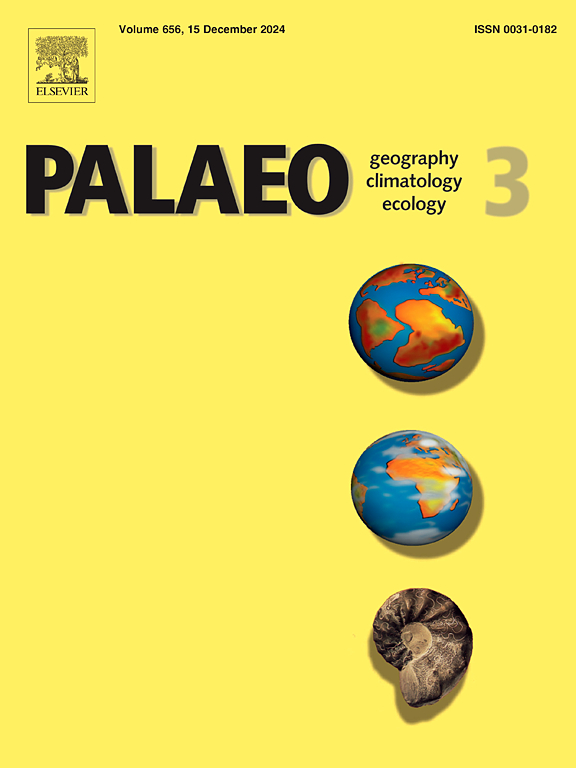阿拉伯海Laxmi盆地大规模海底滑坡后底栖有孔虫的恢复(IODP U1457)
IF 2.7
2区 地球科学
Q2 GEOGRAPHY, PHYSICAL
Palaeogeography, Palaeoclimatology, Palaeoecology
Pub Date : 2025-07-21
DOI:10.1016/j.palaeo.2025.113150
引用次数: 0
摘要
海底块体搬运沉积(MTDs)是由大量沉积物下坡搬运而形成的沉积沉积,通常在海洋环境中。这种沉积物的证据是在国际海洋发现计划(IODP)第355次探险期间在阿拉伯海的Laxmi盆地发现的。Laxmi盆地的MTDs包括基质支撑的碳酸盐角砾岩、改造后的印度河沉积物、西印度河流的物质以及一些来自德干圈闭的物质。估计发生在晚中新世(~ 11 ~ 9 Ma)。沉积物来源的多样性表明,该地区经历了显著的沉积负荷,造成了不稳定。在这项研究中,我们对MTDs内的底栖有孔虫类群进行了有孔虫分析,以了解沉积和随后的改造过程中的环境条件。与未受干扰的沉积物相比,MTDs底栖有孔虫群落的多样性降低,丰度发生变化,反映了与质量运输事件相关的应激和快速沉积。由于沉积物结构的变化,Cibicidoides、Epistominella、Gavelinopsis和Oridorsalis分类群中的特定类群难以生存,这进一步引发了影响有孔虫食物来源的有机质的变化。被认为是氧气最低区(OMZ)分类群的底栖有孔虫被掩埋,在事件中留下了破碎的碎片,影响了该地区的丰度、多样性和群落结构。沉积物底水氧含量均小于0.7 mL/L,揭示了沉积过程中缺氧条件改变了沉积物养分分布。多样性指数在MTD期间显著下降,表明底栖有孔虫群落正逐渐恢复或物种组成发生变化。这个过程的特点是演替,在一个更稳定的群落建立之前,先锋物种在新的沉积物中定居。尽管存在挑战,但有孔虫和地球化学指标表明,了解与MTD相关的古环境影响具有重要意义。本文章由计算机程序翻译,如有差异,请以英文原文为准。
Benthic Foraminiferal recovery following a massive Submarine Landslide in the Laxmi Basin, Arabian Sea (IODP U1457)
Submarine mass transport deposits (MTDs) are sedimentary deposits formed by transporting large amounts of sediment downslope, usually in a marine setting. Evidence of such deposits was found in the Laxmi Basin, Arabian Sea, during the International Ocean Discovery Program (IODP) Expedition 355. The MTDs of the Laxmi Basin include matrix-supported carbonate breccia, reworked Indus-derived sediment, material from western Indian rivers, and some from the Deccan Traps. It is estimated to have occurred during the Late Miocene period (∼11 to 9 Ma). The diverse sediment sources suggest that the region had undergone significant sedimentary loading, contributing to instability. In this study, we conducted foraminiferal analysis to examine the benthic foraminiferal groups within MTDs to gain insights into the environmental conditions during deposition and subsequent reworking. Benthic foraminiferal communities in MTDs show reduced diversity and altered abundance compared to undisturbed sediments in the region, reflecting the stress and rapid deposition associated with mass transport events. The specific group of species belonging to Cibicidoides, Epistominella, Gavelinopsis, and Oridorsalis taxa struggled to exist due to changes in sediment texture, which further primed variation in the organic matter affecting the foraminiferal food sources. The benthic foraminifera, which were considered as oxygen minimum zone (OMZ) taxa were buried, leaving behind broken fragments during the event and affecting the region's abundance, diversity, and community structure. The bottom water oxygen estimated in these sediments was less than 0.7 mL/L, revealing the dysoxic conditions that altered the sediment nutrient distribution during deposition. The diversity index shows a significant decrease during MTD, indicating that the benthic foraminiferal community is experiencing gradual recovery or shifts in species composition over time. This process is characterized by succession, where pioneer species colonize the new sediments before a more stable community establishes itself. Despite the challenges, the foraminiferal and geochemical proxies demonstrate the importance of understanding the paleoenvironmental impacts associated with MTD.
求助全文
通过发布文献求助,成功后即可免费获取论文全文。
去求助
来源期刊
CiteScore
5.90
自引率
10.00%
发文量
398
审稿时长
3.8 months
期刊介绍:
Palaeogeography, Palaeoclimatology, Palaeoecology is an international medium for the publication of high quality and multidisciplinary, original studies and comprehensive reviews in the field of palaeo-environmental geology. The journal aims at bringing together data with global implications from research in the many different disciplines involved in palaeo-environmental investigations.
By cutting across the boundaries of established sciences, it provides an interdisciplinary forum where issues of general interest can be discussed.

 求助内容:
求助内容: 应助结果提醒方式:
应助结果提醒方式:


